
Image: Huawei.
The Solar & Storage Live Virtual Exhibition was held online on the 2nd December 2020. Hariram Subramanian, CTO of Digital Power in Europe of Huawei gave a speech on the topic of 10 trends in EV charging infrastructure. He shared Huawei's insights on the future of EV charging infrastructure, and demonstrated a willingness and determination to build a green and efficient industry ecosystem with major operators, charging infrastructure manufacturers, and automotive enterprises in the industry to continuously create more value and a better experience for customers, facilitate the EV charging infrastructure to develop rapidly and healthily.
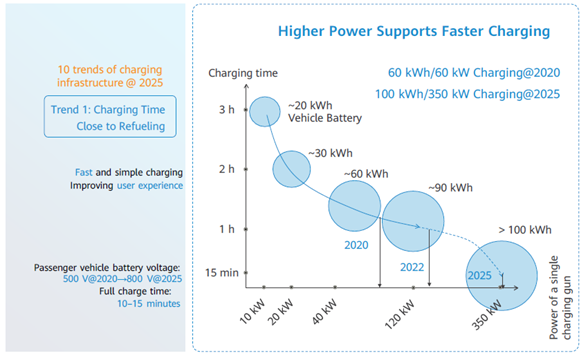
Image: Huawei.
Trend 1: EV Charging will be close to a refueling experience
In the next few years, the charging voltage of passenger cars will be upgraded from 500V to 800V, the charging power of a single gun/charger will be increased from 60kW to 350kW, and the charging time will be shortened from about 1 hour to 10-15 minutes, close to the fueling experience.
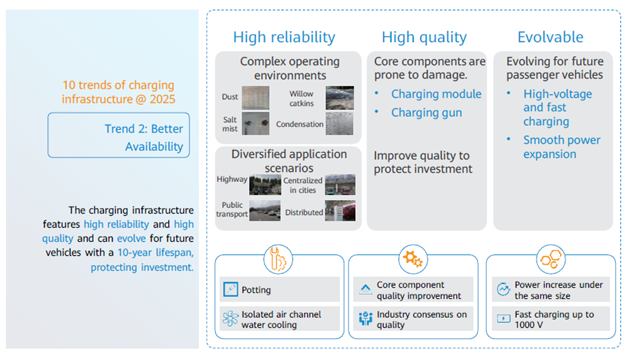
Image: Huawei.
Trend 2: Better availability of charging facilities
The charging infrastructure must have high availability, high reliability, and high quality, and be able to adapt to complex and harsh operating environments, such as high temperature and humidity, salty air, and dust. Core components, such as charging guns/chargers and charging modules, must be of high quality. The charging facilities must be able to evolve smoothly to support larger charging power and higher charging voltage for future passenger vehicles, avoiding overall replacement caused by evolution failures.
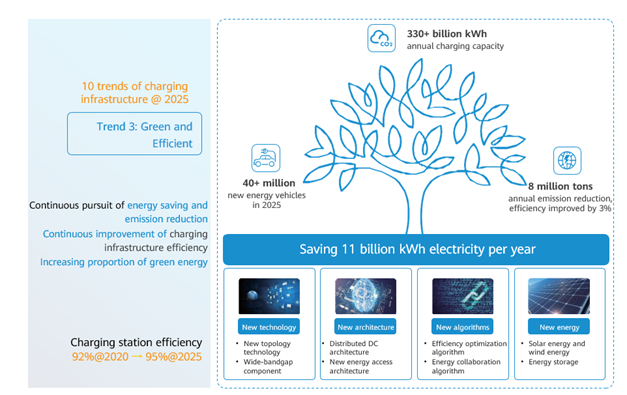
Image: Huawei.
Trend 3: Energy saving and greener environment
By 2025 globally, there will have 40 million electric vehicles with an annual charging capacity of more than 330 billion kWh. If the efficiency is improved by 3%, 11 billion kWh of electricity will be saved, 8 million tons of carbon emissions will be reduced. Through solid-state transformers, new topologies, new components, and new algorithms, the design of charging stations add new energy sources such as PV and energy storage to continuously build a green and efficient charging network.
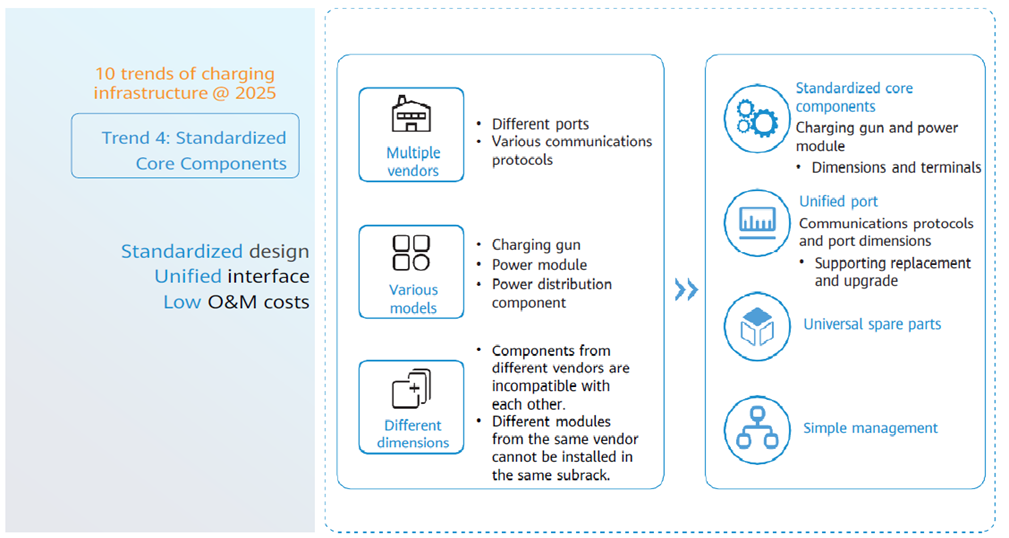
Image: Huawei.
Trend 4: Standardisation of core components
Charger modules from different vendors vary in models and dimensions, and cannot be replaced or compatible with each other.
Currently, charging infrastructures with multiple vendors, product models, and component varies in sizes. Many charging stations have to be replaced due to the lack of spare parts, expensive spare parts, and no manufacturer's maintenance, which will bring huge losses to investors and society. Therefore, we must continue to standardise the common, vulnerable, and core components. Under the same dimensions, the module power increases from 20kW to 30kW and evolves to 40kW in the future enabling module standardisation, modularisation, and evolution.
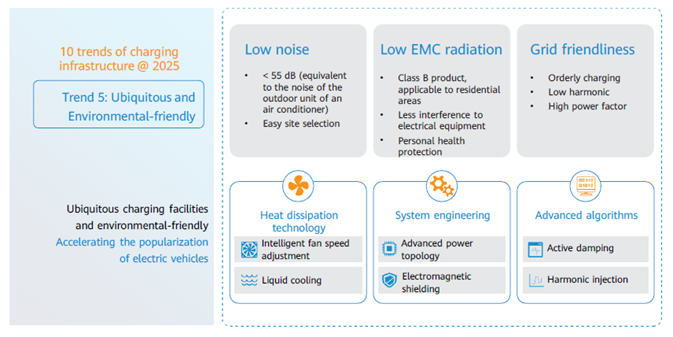
Image: Huawei.
Trend 5: Ubiquitous and environmentally friendly
With the popularisation of EVs, charging infrastructure will become ubiquitous. Charging stations have been deployed in shopping malls, office areas, residential areas, hospitals, and sanatoriums. Therefore, as charging facilities are deployed on a large scale, noise, EMC, and power grid friendliness become the focus of charging station to ensure it is environmentally friendly. Firstly, improve the heat dissipation design of modules and charging stations to achieve low noise. Secondly, strictly comply with the EMC design standards, and adopt power topology innovation and electromagnetic shielding design to reduce electromagnetic radiation and impact on electrical equipment and the human body. Thirdly, use advanced power control algorithms to reduce the impact of high-power charging on the power grid. To achieve these three “friendliness” new technologies, intelligent technologies, and system engineering must be adopted, and standards must be improved and implemented strictly.
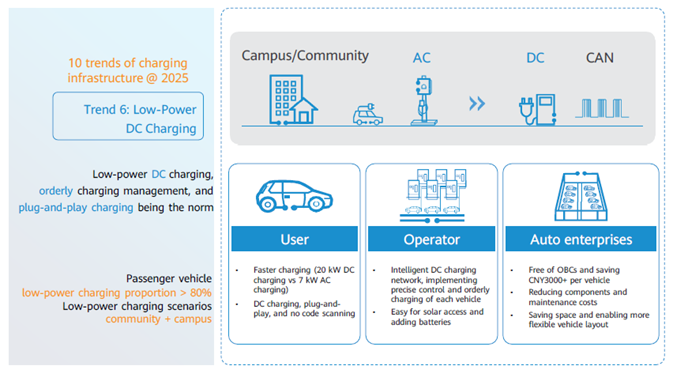
Image: Huawei.
Trend 6: Low-power DC charging
By 2025, the number of electric vehicles will reach 15 million in Europe, and 80% of passenger vehicle charging will come from low-power charging in residential/campus scenarios. This will cover the last mile charging network and promote the large-scale construction of charging stations in residential/campus areas. This will become a key element to improve the convenience of vehicle charging. In the future, the low-power DC charging solution will replace the AC charging solution to make charging faster (20kW DC vs. 7kW AC). The solution can implement plug-and-play charging without scanning any code. The future-oriented low-power DC charging solution focuses on vehicle and charging station collaboration and orderly charging. It will become one of the key technologies for residential and campus charging scenarios.
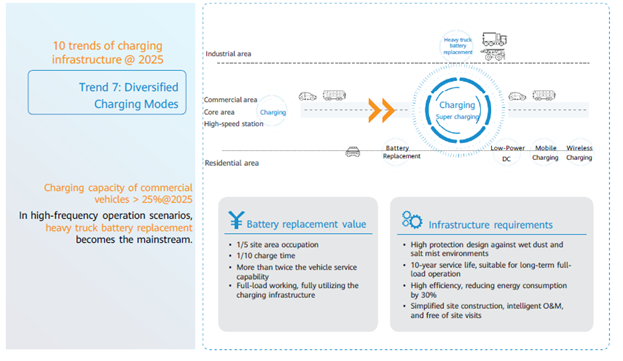
Image: Huawei.
Trend 7: Diversified charging modes
According to industry forecasts, the charging demand of commercial electric vehicles will increase by over 25% in 2025. The electrification of transportation vehicles, represented by electric heavy trucks, will become a major growth point. In addition to charging electric buses or passenger vehicles, charging services will also cover special-purpose vehicles, such as heavy trucks, sanitation vehicles, and port AGVs, supporting differentiated charging for various kinds of vehicles. Charging facilities for heavy trucks should feature simple site selection, a small footprint, and easy O&M. Therefore, the battery replacement solution that meets the requirements of high frequency, high battery level, short-time charging, and intensive construction is becoming more popular in the industry.
The following are key requirements for the battery replacement infrastructure of trucks: high reliability to meet harsh environment requirements; 10-year long service life for long-term full-load running; high efficiency to match large charging capacity; intelligent O&M to eliminate site visits.
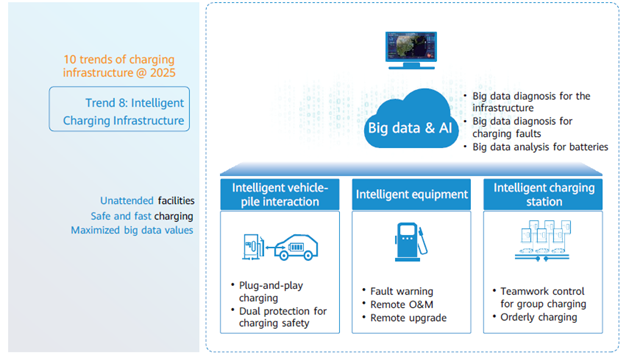
Image: Huawei.
Trend 8: Digital and intelligent charging facilities
Smart grids, IoT, 5G communications, remote control, cloud computing, big data, artificial intelligence, and IoV enable intensive operation and smart travel. The charging infrastructure is digitalised and has become more intelligent in terms of charging experience, O&M, and network collaboration. It enables a secure and fast charging experience, unattended and remote O&M, intelligent and efficient charging facilities.
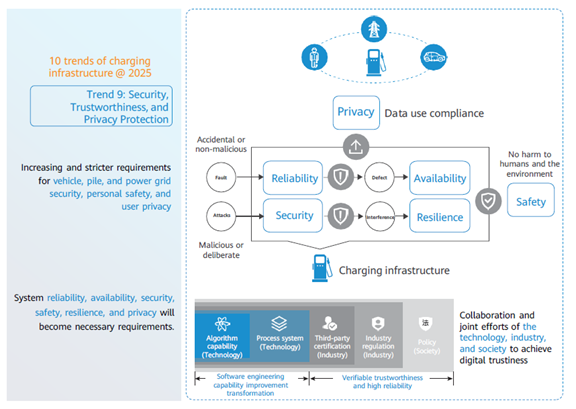
Image: Huawei.
Trend 9: Tighter control for safety and privacy protection
The charging infrastructure is not only an electrical device, but also a network device. It is directly scheduled and managed by the power grid and has multiple attributes, posing high requirements on security, trust, and privacy protection. The following requirements must be met:
- High reliability: low failure rate, high device safety, and no harm to humans and the environment
- High network security: capability to defend against online or local malicious attacks
- High availability: redundancy processing capability for defects
- High resilience: robustness to interference, strict privacy protection, and compliant use of personal and vehicle privacy data
Through the joint development of social awareness, industry standards, and technical guidance and implementation, we can achieve digital trust in the charging infrastructure and ensure the long-term and healthy development of the charging industry.
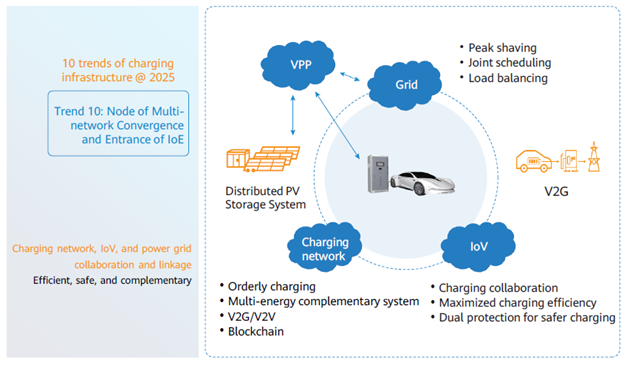
Image: Huawei.
Trend 10: Charging infrastructure is a node for multi-network convergence
Multiple networks, such as the power grid, charging network, and Internet of Vehicles, are converged on this node. In terms of power grids, the local power distribution network will have the collaboration of PV and energy storage, and the scheduling and use of VPP virtual power plants. The power grid frequency and peak adjustment must be supported. Charging networks support orderly charging and blockchain technologies to support market transactions. In terms of IoV, people, vehicles, and charging stations are coordinated to implement cloud BMS management. In the next few years, the charging infrastructure will become a key entry point for the “Energy Internet”. The charging infrastructure will fully play its role in the integration of power infrastructure investment and Internet infrastructure, and implement various new technologies and models to achieve a truly “green energy society”.
According to the ten trends released by Huawei, imagining the future development trend of EV charging infrastructure will continuously strengthen cooperation and communications with partners and industry peers such as charging operators, charging station manufacturers, and charging module manufacturers, which will build a good ecosystem cooperation system. Together, Huawei will help to build the charging infrastructure for EV, accelerate the formation of charging networks on highways and in urban and rural areas, and accelerate the development of the EV industry as a core strategy, with the aim to create values for customers, the industry and the society.
For more information, please visit Huawei online at www.huawei.com

